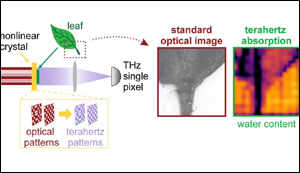Lasers and terahertz waves combined in camera that sees 'unseen' detail
19. 2. 2020 | Science Daily | www.sciencedaily.com
A team of physicists at the University of Sussex has successfully developed the first nonlinear camera capable of capturing high-resolution images of the interior of solid objects using terahertz (THz) radiation.
Images produced using THz radiation are called 'hyperspectral' because the image consists of pixels, each one containing the electromagnetic signature of the object in that point. Lying between microwaves and infrared in the electromagnetic spectrum, THz radiation easily penetrates materials like paper, clothes and plastic in the same way X-rays do, but without being harmful. It is safe to use with even the most delicate biological samples. THz imaging makes it possible to 'see' the molecular composition of objects and distinguish between different materials -- such as sugar and cocaine, for example.

Explaining the significance of their achievement, Prof Peccianti said: "The core challenge in THz cameras is not about collecting an image, but it is about preserving the objects spectral fingerprint that can be easily corrupted by your technique. This is where the importance of our achievement lies. The fingerprint of all the details of the image is preserved in such a way that we can investigate the nature of the object in full detail."
Read more at Science Daily
Image Credit: University of Sussex
-jk-




